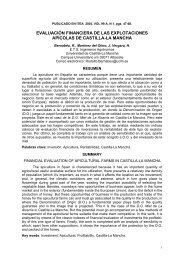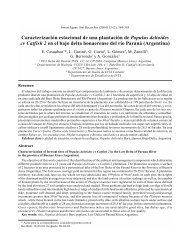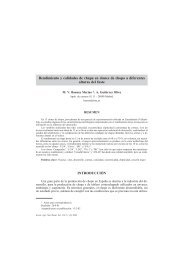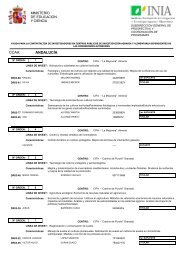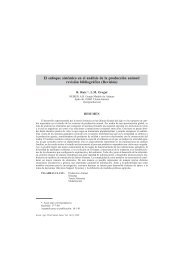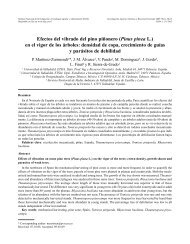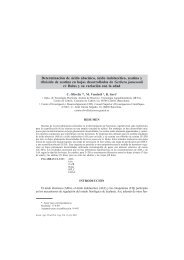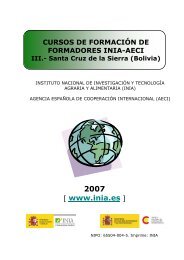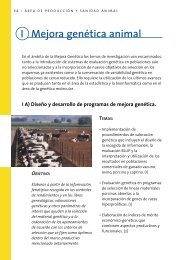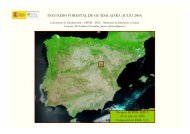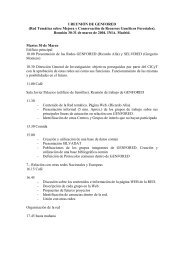Status of medicinal and aromatic plants in - Inia
Status of medicinal and aromatic plants in - Inia
Status of medicinal and aromatic plants in - Inia
Create successful ePaper yourself
Turn your PDF publications into a flip-book with our unique Google optimized e-Paper software.
104<br />
WORKING GROUP ON MEDICINAL AND AROMATIC PLANTS: FIRST MEETING<br />
Nowadays, MAPs <strong>in</strong> Pol<strong>and</strong> are cultivated on an area <strong>of</strong> ca. 20 000 ha. The ma<strong>in</strong><br />
cultivated species are (<strong>in</strong> descend<strong>in</strong>g order <strong>of</strong> acreage <strong>and</strong> tonnage <strong>of</strong> purchased raw<br />
material): Oenothera sp. (seeds) > Carum carvi (fruits) > Silybum marianum (fruits) > Mentha<br />
piperita (leaves) > Chamomilla recutita (<strong>in</strong>florescences) > Origanum majorana (herb) > Valeriana<br />
<strong>of</strong>fic<strong>in</strong>alis (roots) > Thymus vulgaris (herb) > Melissa <strong>of</strong>fic<strong>in</strong>alis (herb) > Cori<strong>and</strong>rum sativum<br />
(fruits) > Borago <strong>of</strong>fic<strong>in</strong>alis (seeds) > Cynara scolymus (herb) > Althaea <strong>of</strong>fic<strong>in</strong>alis (roots) ><br />
Archangelica <strong>of</strong>fic<strong>in</strong>alis (roots) > Levisticum <strong>of</strong>fic<strong>in</strong>ale (roots) > Salvia <strong>of</strong>fic<strong>in</strong>alis (leaves) ><br />
Ech<strong>in</strong>acea purpurea (herb <strong>and</strong> roots) > Ribes nigrum (seeds) > Ruta graveolens (herb) > Plantago<br />
lanceolata (leaves).<br />
The ma<strong>in</strong> MAP raw materials exported by Pol<strong>and</strong> are: Carum carvi (fruits) > Oenothera sp.<br />
(seeds) > Valeriana <strong>of</strong>fic<strong>in</strong>alis (roots) > Mentha piperita (leaves) > Thymus vulgaris (herb) ><br />
Chamomilla recutita (<strong>in</strong>florescences) > Potentilla erecta (rhizomes) > Hypericum perforatum<br />
(herb) > Borago <strong>of</strong>fic<strong>in</strong>alis (seeds) > Tilia cordata (<strong>in</strong>florescences).<br />
The cultivation <strong>of</strong> MAPs <strong>in</strong> "ecological farms" (practic<strong>in</strong>g organic farm<strong>in</strong>g) <strong>in</strong> Pol<strong>and</strong><br />
started <strong>in</strong> the beg<strong>in</strong>n<strong>in</strong>g <strong>of</strong> the 1990s. Unlike that <strong>of</strong> agricultural <strong>and</strong> animal organic<br />
production, the <strong>in</strong>crease <strong>in</strong> organic MAPs' acreage is relatively slow. Organic MAP<br />
production is currently concentrated ma<strong>in</strong>ly <strong>in</strong> southeastern Pol<strong>and</strong>. Seven major MAP<br />
species are cultivated <strong>in</strong> 80 organic farms (Table 4) <strong>and</strong> about 15 other MAP species are<br />
cultivated on smaller areas.<br />
Table 4. Major MAP species cultivated <strong>in</strong> organic farms <strong>in</strong> Pol<strong>and</strong><br />
Species<br />
Cultivated area (ha)<br />
Oenothera sp. 25<br />
Borago <strong>of</strong>fic<strong>in</strong>alis 5<br />
Valeriana <strong>of</strong>fic<strong>in</strong>alis 3<br />
Thymus vulgaris 3<br />
Nigella sativa 3<br />
Mentha piperita 2<br />
Ribes nigrum (leaves) 5<br />
In 2001, 10 t <strong>of</strong> Rubus idaeus leaves <strong>and</strong> 6 t <strong>of</strong> Urtica dioica leaves were collected from<br />
natural sites as raw materials.<br />
In a few major Polish cities (e.g. Warsaw, Kraków, Poznań <strong>and</strong> Gdańsk) about 20 shops<br />
specialized <strong>in</strong> organic food <strong>of</strong>fer MAP products orig<strong>in</strong>at<strong>in</strong>g both from Pol<strong>and</strong> <strong>and</strong> from<br />
abroad. Such products are also sold <strong>in</strong> chosen grocers’ shops, under the special control <strong>of</strong> the<br />
Polish Ecological Club <strong>in</strong> the town <strong>of</strong> Gliwice.<br />
There are about 2500 herbal medic<strong>in</strong>es, estimated at 200 million US$ per year, on the<br />
Polish market. These <strong>in</strong>clude simple <strong>medic<strong>in</strong>al</strong> forms (e.g. dried herbs, herb mixtures,<br />
granulates), more processed forms (e.g. tablets, capsules, dragees) <strong>and</strong> half-f<strong>in</strong>ished products<br />
for pharmaceutical, cosmetic <strong>and</strong> food <strong>in</strong>dustry (extracts <strong>and</strong> essences).<br />
For the production <strong>of</strong> extracts about 4000 t <strong>of</strong> raw materials <strong>of</strong> wild-grow<strong>in</strong>g <strong>plants</strong> <strong>and</strong><br />
about 8000 t <strong>of</strong> cultivated <strong>plants</strong> are used, most frequently Hypericum perforatum, Urtica dioica,<br />
Valeriana <strong>of</strong>fic<strong>in</strong>alis, Betula verrucosa, Cynara scolymus, Chamomilla recutita, Silybum marianum,<br />
Equisetum arvense <strong>and</strong> Thymus vulgaris. Herbal medic<strong>in</strong>es are used mostly aga<strong>in</strong>st disorders<br />
<strong>of</strong> the digestive tract <strong>and</strong> as tonics <strong>and</strong> strengtheners. Among Polish plant preparations the<br />
most popular are Sylimarol, Raphachol<strong>in</strong> C <strong>and</strong> Tussipect (Lutomski 1999).




